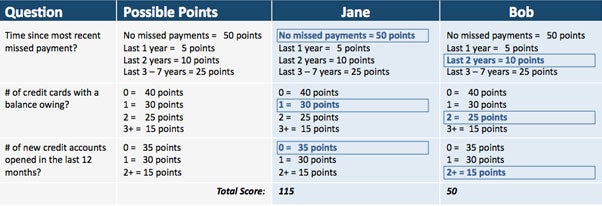 While knowing your credit score is important, understanding the context of where your score resides within the overall score range, and having insight into why it’s not higher, empowers you to focus on score improvement strategies that will help you successfully increase your credit score and gain access to better credit terms—which ultimately saves you money.
While knowing your credit score is important, understanding the context of where your score resides within the overall score range, and having insight into why it’s not higher, empowers you to focus on score improvement strategies that will help you successfully increase your credit score and gain access to better credit terms—which ultimately saves you money.
When a credit score is generated, there are a series of credit related questions being asked by the scoring model, and the answers for each question will depend on the information (or data) being reported in your credit report. Points for each answer to each question are assigned and the sum of these points is generated to create your credit score.
Let’s take a look at the made up example scorecard below and the associated scores for Jane and Bob. The information highlighted in blue represents the points assigned for each credit question based on information reported in their credit reports:
After the score is calculated, score reason codes are generated along with the score – both of which are provided to the lender who requested the credit report. If the lender denies the request for credit, they will often incorporate these reason codes into the adverse action letter they are obligated to provide to you in order to help explain why the credit request was denied. These reason codes are also frequently included within the score explanation section when you purchase access to your personal credit report and score.
[Featured Tool: Get your free Credit Report Card from Credit.com]
These reason codes indicate the main reasons why your credit score was not higher and are returned with the score in order of importance–with the first code indicating where the consumer lost the most points, or the primary reason why the score wasn’t higher, the second being the secondary reason, and so on.
Now, let’s calculate the top reasons why Bob’s score wasn’t higher. We do this by simply subtracting the total number of points Bob received from the maximum number of points available for each “question” in the scorecard:
These are then sorted in order of impact of where the greatest number of points were lost. For Bob, the following credit score and score reason codes would be returned as:
Bob’s Credit Score = 50
Top reasons why Bob’s score was not higher:
- Time since most recent missed payment too recent
- Too many new accounts recently opened
- Too many accounts with a balance
With this information, Bob is able to understand what credit behaviors had the most substantial impact on his score and where he needs to currently focus his efforts in order to improve his score.
[Related Article: The Politics of the Credit Score]
Up to four reason codes are returned with each score generated by the credit reporting agency. In some cases, a fifth reason code is provided, but only if the # of credit inquiries is a factor that affected your score—but was not already in the top four reasons. Even people with really high scores—say a 790 or higher—may return reason codes with their score. This simply represents areas where the high scoring person just missed earning the maximum number of points available for that particular data element.
Now that we’ve determined Bob’s reason codes, how many reason codes would Jane’s score produce? Know the answer? Share them in the comments section below.
Image by Stewf, via Flickr
You Might Also Like
March 7, 2023
Credit Score
January 4, 2021
Credit Score
September 29, 2020
Credit Score







